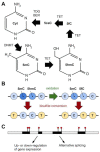Malaria in the 'Omics Era'
- PMID: 34070769
- PMCID: PMC8228830
- DOI: 10.3390/genes12060843
Malaria in the 'Omics Era'
Abstract
Genomics has revolutionised the study of the biology of parasitic diseases. The first Eukaryotic parasite to have its genome sequenced was the malaria parasite Plasmodium falciparum. Since then, Plasmodium genomics has continued to lead the way in the study of the genome biology of parasites, both in breadth-the number of Plasmodium species' genomes sequenced-and in depth-massive-scale genome re-sequencing of several key species. Here, we review some of the insights into the biology, evolution and population genetics of Plasmodium gained from genome sequencing, and look at potential new avenues in the future genome-scale study of its biology.
Keywords: Plasmodium; genomics; malaria; methylation; methylomics.
Conflict of interest statement
The authors declare no conflict of interest.
Figures



References
-
- Galen S.C., Borner J., Martinsen E.S., Schaer J., Austin C.C., West C.J., Perkins S.L. The polyphyly of Plasmodium: Comprehensive phylogenetic analyses of the malaria parasites (order Haemosporida) reveal widespread taxonomic conflict. R. Soc. Open Sci. 2018;5:171780. doi: 10.1098/rsos.171780. - DOI - PMC - PubMed
-
- Sutherland C.J., Tanomsing N., Nolder D., Oguike M., Jennison C., Pukrittayakamee S., Dolecek C., Hien T.T., Rosário V.E.D., Arez A.P., et al. Two Nonrecombining Sympatric Forms of the Human Malaria Parasite Plasmodium ovale Occur Globally. J. Infect. Dis. 2010;201:1544–1550. doi: 10.1086/652240. - DOI - PubMed
Publication types
MeSH terms
LinkOut - more resources
Full Text Sources
Medical

